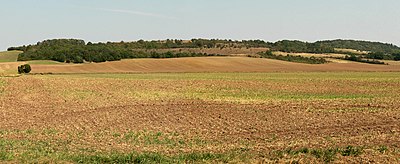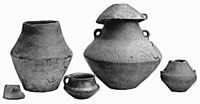Beierstedt cemetery
The Beierstedt cemetery is located near Beierstedt in the Helmstedt district . The burial place with urns was in the period from about 900 to 600 BC. Used. The burial ground is assigned to the domestic urn culture and lies within its range on the northwestern edge.
description

The grave field is located on the southern slope length below the Heeseberg about 400 meters west of Beierstedt and about 800 meters southeast of the Hünenburg near Watenstedt . The occupation time of the burial ground can be attributed to the Younger Bronze Age and the Early Iron Age . In accordance with the burial custom of the time, the burials took place in urns with the cremated remains of the deceased. Some of the urns were placed free-standing in the ground. Others were protected by stone packings or stone boxes of rectangular or square shape, which is typical in the area. In one case, the underground stone protection was marked in color by red and white stones. Due to the conspicuous stone setting, the archaeologists assume that there were previously surface grave markings.
The graves were rich in grave goods . These include iron and bronze razors, glass beads, arm rings and jewelry pins. A special find was a personal care set consisting of tweezers, an ear spoon and a nail scraper. In the grave of a 40- to 60-year-old man there was a blue and yellow patterned glass bead that was common in Croatia and northern Italy. It is the first pearl of its kind found north of the Alps .
- Urn finds from 1891 and 1892
Research history
The burial ground has been known since the end of the 19th century. In the years 1891 and 1892 the first excavations were carried out by the Beierstedt farmer August Vasel (1848-1910); he uncovered 68 of the urn graves. Of these, he secured 21 grave inventories, which had been completely preserved; He left the broken urns on site. Vasel donated the preserved pieces with his extensive collection to the Herzog Anton Ulrich Museum in Braunschweig in 1897 . Today the urns are in the Prehistory and Early History department of the Braunschweigisches Landesmuseum in Wolfenbüttel and in the Museum for Prehistory and Early History in Berlin .
More recently, the cemetery was prospected geophysically in connection with the investigations of the Hünenburg near Watenstedt in 2006 and 2008 . The investigations funded by the German Research Foundation were carried out with the magnetometer , whereby ground-penetrating radar was also used on a small scale to detect stone grave cover plates. During excavations in 2007 and 2008, a number of graves were found at the prospected suspect points. A total of 77 graves were uncovered. These excavations were under the direction of the archaeologists Immo Heske and Mario Pahlow , among others .
interpretation
Due to the rich grave goods, archaeologists assume that privileged residents of the Hünenburg near Watenstedt and its outlying settlement were buried there. The Hünenburg is considered a former supraregional center of trade and power. The additions indicate cultural contacts in the north, east and south as far as the Adriatic . Based on the finds, a mobility of people, possibly based on marriage relationships, in the area of Thuringian culture and as far as the Saale region could be proven.
literature
- Theodor Voges : The excavations of Beierstedt in the journal of the Harz Association for History and Archeology, 1894, pp. 575–589 ( online , pdf)
- Immo Heske : The cemetery of Beierstedt in: The Hünenburg near Watenstedt, Ldkr. Helmstedt. A prehistoric fortification and its surroundings. , Neumünster 2006, pp. 144–155
- Immo Heske: red flames and white bones. On the Beierstedt urn cemetery in Archeology in Lower Saxony , pp. 36–40
- Immo Heske: The cemetery of Beierstedt, Kr. Helmstedt. Report on the excavations on a Young Bronze and Early Iron Age burial site of the house urn culture in 2007 and 2008 in Nachrichten aus Lower Saxony's Urgeschichte 79, 2010, pp. 85–111
- Immo Heske: The grave field - elaborate grave construction and stately furnishings in: Window into archeology. 300,000 years of history in the Braunschweiger Land around the Elm , Braunschweig 2013, pp. 141–142
- Simone Menck: The burial ground of the house urn culture from Beierstedt, Ldkr.Helmstedt in the series: Göttinger Schriften zur Vor und Frühgeschichte , Volume 35, 2017
Web links
- Iron spindles and bronze needles as an addition in the Braunschweiger Zeitung of August 29, 2007
Coordinates: 52 ° 4 '52 " N , 10 ° 51' 2.2" E



